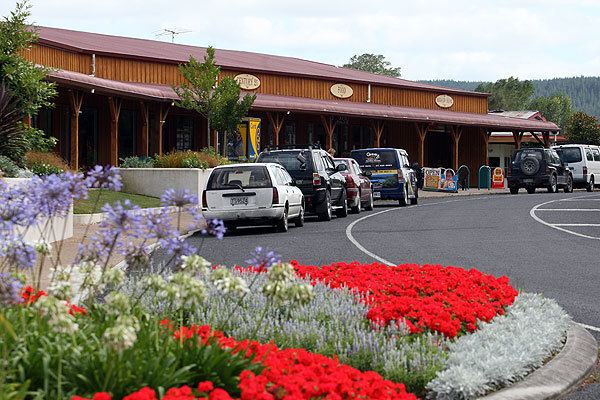Local time Monday 1:50 PM | District Taupo District | |
 | ||
Settlements of Taupo ListTaupoKinlochTurangiMangakino Weather 19°C, Wind W at 21 km/h, 70% Humidity | ||
Mangakino is a small town on the banks of the Waikato River in the North Island of New Zealand. It is located close to the hydroelectric power station at Lake Maraetai, 85 kilometres (53 mi) southeast of Hamilton. Its population in 2001 was 1257. The town and its infrastructure are administered as the Mangakino Pouakani ward by the Taupo District Council
Contents
Map of Mangakino 3492, New Zealand
History
In 1896, (after 40 years of resistance) the Crown acquired the Wairarapa Lakes from Ngāti Kahungunu and in 1915, gave in return land in middle North Island, land known as part of the Pouakani Block. At that time the land where Mangakino lies today was described as native bush and pumice wastelands, barren, unoccupied and unfarmed. In 1946, as the Karapiro Dam neared completion, workers were to transfer to the next dam construction site – 'Maraetai I', near Mangakino. The Crown, under the Public Works Act, reacquired a portion of the unoccupied Pouakani Block alongside the Waikato River to build a “hydroelectric station” and a temporary township, Mangakino, was established to house the hundreds of construction workers needed. The town was only ever meant to be there on a temporary basis until the completion of the proposed dams.
The city planner Ernst Plischke who emigrated from Austria in 1939 developed a plan for the town centre of Mangakino, which was put into action in 1947-1948. His plan included a pedestrian area in the town centre free from through traffic.
In 1952 the population exceeded 5,000. Mangakino also serviced the construction of Atiamuri and Ohakuri hydro schemes further upstream which were commissioned in 1959 and 1961 respectively. Mangakino and to a lesser extent Whakamaru and Atiamuri, owe their existence to the hydro schemes and the roads constructed gave access which allowed development of the land for farming in the 1960s. The decline for Mangakino occurred after the hydro dams were commissioned and over time communities such as Maraetai and Waipapa disappeared altogether.
In 2001, the Mangakino Township Incorporation obtained approval through the Māori Land Court to legally change the title of the majority of residential sections in Mangakino from Maori land to General title. They then put Mangakino’s 500+ leasehold sections on the market as a single purchase. In July 2002, the majority of the town’s sections were sold to MV Properties of Pukekohe. A stipulation of the tender was that residents would be given the first opportunity to purchase their perpetually leased sections. The land valuations that had been exceedingly low for decades, then skyrocketed. Some locals chose to freehold their homes immediately, empty sections without current leases were sold on the open market. Many residents continue to remain perpetual leaseholders.
Notable residents
Prominent former citizens of Mangakino include:
